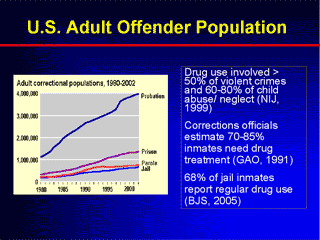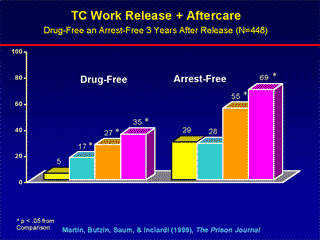Extent of the Problem
 The connection between drug abuse and crime for adults
and juveniles is well known. As seen in Figure 1, the
number of adults involved in the criminal justice system
has soared to 6.9 million. Many offenders convicted of
drug-related crimes have substance abuse problems.
The connection between drug abuse and crime for adults
and juveniles is well known. As seen in Figure 1, the
number of adults involved in the criminal justice system
has soared to 6.9 million. Many offenders convicted of
drug-related crimes have substance abuse problems.
Approximately half of State and Federal prison, as well as
local jail, inmates meet standard diagnostic criteria (DSMIV)
for alcohol/drug dependence or abuse. Yet data
indicate that only 13% of those needing drug abuse
treatment receive it while incarcerated, meaning that many
of the 650,000 inmates released back into the community
annually have not received needed treatment services.
Left untreated, drug-abusing offenders can relapse to drug
use and return to criminal behavior. This jeopardizes
public health and public safety leading to re-arrest and re-incarceration, further taxing an already over-burdened
criminal justice system.
NIDA's Integrated Public Health-Public Safety Response
Research demonstrates that providing treatment to individuals involved in the criminal justice system decreases
future drug use and criminal behavior while improving social functioning. Blending the functions of criminal justice
supervision with drug abuse treatment and support services creates an opportunity to have an optimal impact on
behavior by addressing public health concerns while maintaining public safety.
NIDA supports a robust research portfolio examining the integration of drug treatment into criminal justice settings,
including Criminal Justice Drug Abuse Treatment Studies (CJDATS). CJDATS is a multi-site set of research
studies designed to improve outcomes for offenders with substance use disorders by improving the integration of
drug abuse treatment with other public health and public safety systems. CJDATS is the result of numerous
collaborative relationships between NIDA and other agencies including:
- National Institute on Alcohol Abuse and Alcoholism,
- National Institute of Mental Health,
- Substance Abuse and Mental Health Services Administration,
- Centers for Disease Control and Prevention,
- Bureau of Prisons,
- National Institute of Corrections,
- Bureau of Justice Assistance (BJA),
- Drug Court Program Office (BJA), and
- National Institute of Justice.
In fiscal year 2006, NIDA spent $6.8 million to support research at 10 CJDATS sites across the country.
The aims of the NIDA criminal justice portfolio are to (1) develop treatment programs that are available to
offenders moving throughout the criminal justice system; (2) enhance HIV and other infectious disease treatment
and prevention with offenders; and (3) facilitate the transportation of new treatment models into the criminal justice
system.
Treatment Can Work with Criminal Justice Populations
The criminal justice system has several opportunities and mechanisms to refer offenders with substance abuse
problems to treatment. This includes conducting assessments after arrest and enforcing treatment program
requirements during prosecution and sentencing phases that may include drug courts, diversion programs, pretrial
release, and conditional probation with sanctions.
Different treatment approaches are being examined to integrate drug abuse treatment into criminal justice settings.
These include: Treatment Accountability for Safer Communities (TASC), drug courts that blend judicial monitoring
and sanctions with treatment, and therapeutic communities (TCs) in prison and/or community settings after
release.
Aftercare is a Necessary Component of Treatment
 Treatment in prison can reduce drug use and criminal
behavior. Research also strongly indicates that
continuing treatment in the community is needed to sustain
these gains. Combining prison-based treatment (e.g., TCs)
with community-based treatment upon release reduces an
offender's risk of recidivism, decreases substance abuse,
improves prospects for employment, and increases prosocial
behavior (see Figure 2). Case management and
referral to other medical, psychological, and social services
are crucial components of treatment for many offenders.
Treatment in prison can reduce drug use and criminal
behavior. Research also strongly indicates that
continuing treatment in the community is needed to sustain
these gains. Combining prison-based treatment (e.g., TCs)
with community-based treatment upon release reduces an
offender's risk of recidivism, decreases substance abuse,
improves prospects for employment, and increases prosocial
behavior (see Figure 2). Case management and
referral to other medical, psychological, and social services
are crucial components of treatment for many offenders.
Treatment for adults and adolescents is cost-effective
because it reduces costs related to drug use, health care,
and crime, including incarceration. Adding an aftercare
component to in- and out-of-prison treatment programs
results in the greatest cost savings
Addressing Public Health Problems Associated with Drug Abuse
Substance-abusing individuals in the criminal justice system have a host of complicated health problems.
Involvement in the criminal justice system provides an opportunity to diagnose and treat these health problems,
including infectious diseases. Increasing participation in drug abuse treatment can decrease the spread of these
diseases by reducing risky behaviors, such as sharing injection equipment and having unprotected sex. The
prevalence of AIDS is estimated to be approximately 5 times higher among incarcerated individuals than the
general population. In addition, individuals in the criminal justice system represent a significant proportion of all
cases of hepatitis B and C infection and tuberculosis in the U.S.
|